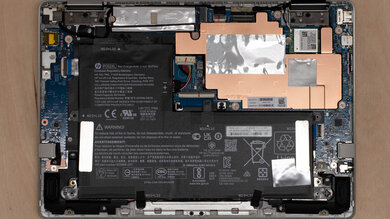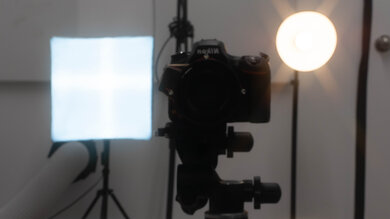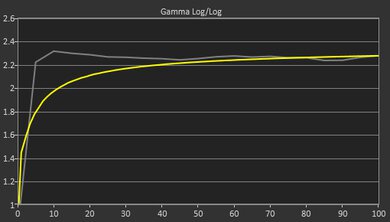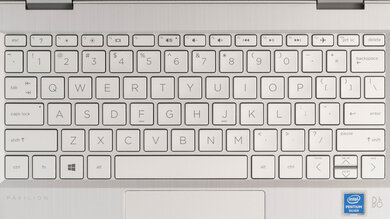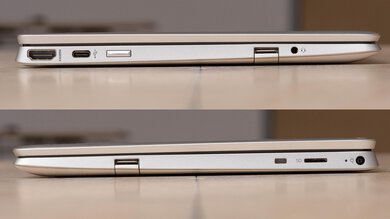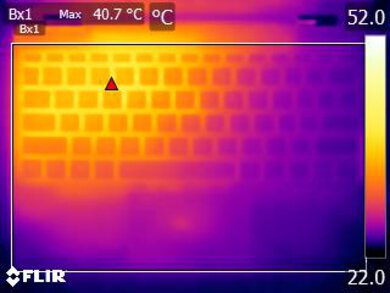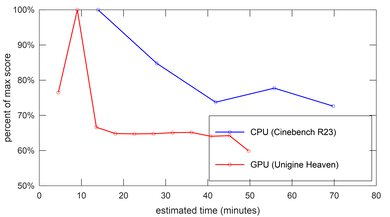The HP Pavilion x360 11 (2021) is a 2-in-1 Windows laptop with a 360-degree hinge. It has an Intel Pentium Silver N5030 CPU, Intel UHD Graphics 605 (integrated), 4GB of memory, and 128GB of storage. It's the only available configuration, and none of the components are user-replaceable except for the storage drive. It sports an IPS display with a resolution of 1366 x 768, a 720p webcam, and a 38Wh battery. Its port selection includes two USB-As, a USB-C (USB 3.2 Gen 1), an SD card reader, and a 3.5mm headphone jack.
Our Verdict
The HP Pavilion x360 11 is okay for school use. It has decent build quality even though it's mostly plastic, and it's easy to carry around thanks to its compact size. The keyboard feels comfortable to type on, the touchpad is responsive, and the webcam captures a good image overall. Unfortunately, the display is too dim for use in well-lit settings, and its small size makes multitasking hard. The battery doesn't quite last eight hours, so you may have to plug it in at some point to finish the day. Its Intel Pentium Silver CPU and integrated graphics can handle light tasks like web browsing and text formatting, but they aren't ideal for demanding workloads, like graphic design or 3D rendering.
- Very portable due to compact size.
- Keyboard feels decent to type on.
- Can be used in tablet mode.
- Good webcam video quality.
- Silent thanks to fanless design.
- Small and dim display.
- Battery lasts less than 8 hours of light productivity.
- May stutter due to limited memory.
- CPU and integrated GPU aren't powerful enough for demanding workloads.
- Can't charge laptop via USB-C.
The HP Pavilion x360 11 is bad for gaming. Its Intel Pentium Silver processor and integrated graphics can't handle graphically demanding games, and they throttle under load. It's also limited to 4GB of RAM, which means some games won't even start, and the display has a basic 60Hz refresh rate with a slow response time and no VRR support.
- Fast storage drive.
- Silent thanks to fanless design.
- May stutter due to limited memory.
- CPU and integrated GPU aren't powerful enough for demanding workloads.
- 60Hz display with no VRR.
- CPU and GPU throttle under load.
The HP Pavilion x360 11 is decent for media consumption. Portability isn't a problem thanks to its compact size, and the battery lasts long enough to get through a couple of movies or TV show episodes. Its 720p display is reasonably sharp, but it looks dim and washed out. It isn't the best for dark rooms either because its low contrast makes blacks appear gray. The speakers get very loud, but like most laptop speakers, they have almost no bass.
- Very portable due to compact size.
- Loud speakers.
- Can be used in tablet mode.
- Speakers sound treble-heavy.
- Small and dim display.
- Blacks look gray in dark settings.
The HP Pavilion x360 11 is bad for use as a workstation. It's only available with a low-power Intel Pentium Silver processor and integrated graphics, which aren't powerful enough for demanding workloads like video editing or 3D rendering. Also, it's limited to 4GB of RAM, and it throttles under load. However, the keyboard deck doesn't get hot, and it's completely silent because it's fanless.
- Fast storage drive.
- Silent thanks to fanless design.
- May stutter due to limited memory.
- CPU and integrated GPU aren't powerful enough for demanding workloads.
- CPU and GPU throttle under load.
- Can't charge laptop via USB-C.
The HP Pavilion x360 is okay for business use. It's a very compact laptop that's easy to carry around, and it feels decently built even though it's mostly plastic. The keyboard provides a decent typing experience, the touchpad is responsive, and the webcam has good video quality. Its Intel Pentium Silver processor can handle most productivity tasks like text formatting, spreadsheets, and presentations. However, you may still experience some stutters or slowdowns because it's limited to 4GB of memory. Unfortunately, the battery doesn't last long enough to get you through a typical 8-hour day, and although it has a USB-C port, you can't use it to charge the laptop.
- Very portable due to compact size.
- Keyboard feels decent to type on.
- Can be used in tablet mode.
- Good webcam video quality.
- Silent thanks to fanless design.
- Small and dim display.
- Battery lasts less than 8 hours of light productivity.
- May stutter due to limited memory.
- CPU and integrated GPU aren't powerful enough for demanding workloads.
- Can't charge laptop via USB-C.
Differences Between Sizes And Variants
We tested the HP Pavilion x360 (model 11m-ap0033dx) with an Intel Pentium Silver N5030 CPU, Intel UHD Graphics 605, 4GB of RAM, and 128GB of storage. There aren't any other configuration options. There are many laptops in the Pavilion x360 lineup of various sizes and configurations, so to avoid confusion, our review only applies to the 11m-ap0000 series. Some models include a 1-year Microsoft Personal 365 subscription.
| Screen |
|
|---|---|
| CPU |
|
| GPU |
|
|
Memory |
|
| Storage |
|
| Color |
|
Our display and performance results are only valid for the configuration that we tested. If you come across a different configuration option not listed above, or you have a similar HP Pavilion x360 11 that doesn't correspond to our review, let us know, and we'll update it. Some tests, like black uniformity and color accuracy, may vary between individual units.
You can see our unit's label here.
Popular Laptop Comparisons
The HP Pavilion x360 11 is okay compared to other laptops in its class. However, it's only suitable for extremely light workloads, as its low-power CPU, limited memory, and small display aren't ideal for demanding tasks or heavy multitasking.
For more options, check out our recommendations for the best laptops under $300, the best budget and cheap laptops, and the best Chromebooks.
The HP Pavilion x360 11 (2021) and the ASUS VivoBook Flip 14 (2020) are both budget 2-in-1 convertible laptops with similar CPU and GPU performance. However, the HP has an 11-inch screen, while the ASUS has a 14-inch screen. The HP's display gets brighter to combat glare, its keyboard feels more comfortable to type on, and its touchpad tracks better. The HP also has a better webcam, a wider port selection, and a faster storage drive. On the other hand, the ASUS has longer battery life and a fingerprint sensor.
The HP Pavilion x360 11 (2021) and the Apple MacBook Air 13 (M1, 2020) are very different. The HP is an 11-inch 2-in-1 convertible Windows laptop, while the Apple is a 13-inch macOS laptop that you can only use in clamshell mode. The Apple is better than the HP in nearly all aspects, like a sharper and brighter display, a more comfortable keyboard, a larger touchpad, and a webcam with better video quality. The Apple also has significantly better CPU and GPU performance, and its battery lasts much longer.
The HP Pavilion x360 11 (2021) and the Apple MacBook Pro 16 (2019) are very different laptops. The HP is a budget 2-in-1 laptop that runs Windows, while the Apple is a premium clamshell laptop that runs macOS. The Apple is better than the HP in every way, but it's also significantly more expensive. That said, if you only need a compact device to browse the web or watch content on the go, the HP is smaller and more portable.
The HP Pavilion x360 11 (2021) and the HP Stream 11 (2021) are both 11.6" Windows laptops; however, the Pavilion x360 has a 360-degree hinge that lets you flip the screen around and use it as a tablet, while you can only use the Stream in clamshell mode. The Pavilion x360 provides a better overall user experience because it has an IPS display with wider viewing angles, a more comfortable keyboard, and a webcam with much better video quality. The Pavilion x360 also feels smoother because its Intel Pentium Silver processor can handle heavier workloads than the Stream's Intel Celeron CPU, and its SSD is significantly faster.
Test Results

The HP Pavilion x360 is a small, compact laptop with a fairly basic design. It has a plastic chassis with a brushed silver finish, thick bezels, and downward-firing speakers. It's a fanless device with no airflow vents.
The HP Pavilion x360 2-in-1 laptop is a very compact device that's easy to carry around. The power adapter is also small and fits easily into most bags.
The HP Pavilion x360's serviceability is passable. To access the internals, you need to remove the four feet, the screws beneath them, and two additional screws before prying the panel open with a pick. They're all Philips screws, but the ones beneath the feet are slightly different, so it's important to keep them organized. The feet come off easily and stick back on without any issue. The laptop comes with a SATA 3 M.2 drive, but it supports PCIe NVMe SSDs, which are typically faster. Unfortunately, the memory is soldered onto the motherboard and isn't user-replaceable.
The HP Pavilion x360 convertible is only available with a 720p IPS panel. Although the resolution seems low, it still looks reasonably sharp because the screen is small. The downside is that you don't get much room for multitasking. The thick bezels are a bit distracting, but that's typical for a laptop in its class. The HP Pavilion x360 14 (2021) is the larger version of this laptop with more screen real estate if you intend to have multiple windows open while multitasking.
The screen brightness is mediocre. It doesn't get bright enough to overcome glare, so it's best suited for a moderately lit room. It gets very dim at the lowest brightness setting, though, which provides a better viewing experience in the dark because it causes less eye strain.
The reflection handling is okay. Its glossy finish does a good job of reducing glare from indirect reflections, but direct reflections like bright light sources are visible and distracting, even with the screen at maximum brightness.
The HP Pavilion x360 has an acceptable horizontal viewing angle. The image looks dimmer and more washed out when viewing from the side, but it's still good enough for sharing the screen with someone else as long as perfect accuracy isn't needed.
The vertical viewing angle is okay. The image remains accurate from slightly above or below, so you have some leeway to tilt the screen to your preference before the image quality degrades.
The HP Pavilion x360 2-in-1 has poor color accuracy out of the box. Most colors are inaccurate due to the panel's narrow color gamut, and it also displays colors outside of the sRGB color space, like pure green. The white balance is off, especially at higher brightness levels, and the color temperature is warm, giving the whole image a slight reddish tint. The gamma is not bad and follows the sRGB curve for the most part, although dark scenes are over-darkened.
The HP Pavilion x360 has a poor color gamut. It doesn't even have full coverage of the commonly-used sRGB color space, so most content looks washed out. It also has very limited coverage of the wider color spaces like Adobe RGB, DCI P3, and Rec. 2020, making it unsuitable for color-critical work or viewing HDR content.
The keyboard is sub-par. It provides a decent typing experience as the keys are stable, have a good amount of travel, and don't require much force to actuate. However, it takes a while to get used to the tight spacing. There's also no backlighting, making it hard to use in dim settings.
The touchpad is okay. It feels smooth even though it's plastic, and it tracks accurately throughout, even around the edges. It's on the small side, though, making any action over long distances like dragging and dropping somewhat annoying.
The speakers are good. They get pretty loud with very little dynamic compression at max volume; however, they're treble-heavy because they have almost no bass. They're good for spoken content, but not for music or movies where you'd expect a deep, thumping sound.
The HP Pavilion x360 has a decent webcam. The image is good, with decent color reproduction, but it looks soft and overexposed. Voices sound clear though slightly nasal over the microphone, with very little background noise.
The HP Pavilion x360 2-in-1 has a decent port selection. The two USB-A ports support the USB 3.2 Gen 1 (up to 5Gbps data transfer rate) standard. The USB-C is also USB 3.2 Gen 1, and you can only use it for data transfer, meaning you can't use it to charge the laptop or for video output.
The wireless adapter is a Realtek RTL8821CE.
The HP Pavilion x360 11 is only available with an Intel Pentium Silver N5030 CPU, a low-power 4-core, 4-thread processor designed for thin and light laptops. It can provide a relatively smooth experience when performing simple tasks like web browsing and video playback, but don't expect to do anything remotely demanding like gaming, video editing, or 3D rendering.
Intel UHD Graphics 605 is an integrated GPU on the Intel Pentium Silver N5030 chip. Like most integrated graphics, it's only powerful enough for light productivity tasks. You can likely play some easy-to-run puzzle games from the Windows Store, but not modern AAA titles.
You can only get the HP Pavilion x360 11 with 4GB of RAM. This is only enough for a light workload, so you have to be fairly conservative in the number of apps you have running simultaneously. Unfortunately, the memory is soldered onto the motherboard and isn't user-upgradeable.
You can only configure the HP Pavilion x360 convertible with a 128GB M.2 SATA 3 SSD. However, the storage drive is user-replaceable, and you can also increase storage space with a microSD card.
The HP Pavilion x360 performs poorly in Geekbench 5. Its low single-thread, multi-thread, and GPU compute scores mean it can only handle light tasks like web browsing, video playback, and text formatting. Depending on your workload, you might even experience some stutters or freezes if you have too many programs running simultaneously.
The Intel Pentium Silver N5030 performs awfully in Blender, taking far too long to render the simple bmw27 scene to be helpful for any practical purposes. Blender doesn't support the integrated GPU; however, it'll likely take longer than the CPU to complete the same scene.
The HP Pavilion x360's storage drive performs well. It's fast enough to make the system boot up quickly and feel responsive, but its somewhat slow sequential write speed means it can take a while to copy large files or install a big program. If you want better storage drive performance to transfer large files or make the system feel more responsive, the M.2 slot supports PCIe NVMe SSDs, which are typically much faster than the SATA 3 SSD that comes with the laptop.
The HP Pavilion x360 has mediocre battery life. It doesn't quite last a full eight hours of light productivity, so you likely have to plug it in at some point. Video playback consumes more power, but you can still comfortably get through two or three full-length movies. Battery life is even shorter when gaming, although it's still better than most laptops. Battery life varies greatly depending on usage.
Borderlands 3 doesn't run on the HP Pavilion x360. The game crashes on startup on DirectX 11 and 12.
Civilization VI doesn't run at high graphical settings, and it only works in DirectX 11 because the game crashes on DirectX 12. It isn't playable with the graphics settings at minimum because the average frame rate is too low.
CS:GO runs terribly on the HP Pavilion x360. The average frame rate is in the single digits whether at high or low graphical settings, far too choppy for an FPS game that requires precise aiming.
Shadow of the Tomb Raider runs at high graphical settings, but it's so laggy that even navigating the main menu is hard. Also, we had to run the game in DirectX 11 because it kept crashing in DirectX 12. The average frame rate at the lowest graphical setting is also far too low to be playable.
The HP Pavilion x360 has excellent thermal and noise handling. There's no fan noise because this is a fanless laptop, and the keyboard deck only gets slightly warm, although the hot spot isn't in the best position as it's close to where most people rest their left hand.
The HP Pavilion x360's performance over time is disappointing. The CPU and GPU throttle even though their temperatures are relatively low. Most processors can run at a much higher temperature without the risk of damage, so this is likely to keep the keyboard deck at a reasonable temperature.
The HP Pavilion x360 11 has Windows 11 in S mode pre-installed. S mode is a stripped-down version of Windows that typically runs smoother on low-end hardware because it requires fewer system resources, but you can only install apps from the Windows Store. You can opt-out of S mode free of charge, but you can't go back to it once you've activated the full version of the operating system.
The HP Pavilion x360 11 comes with many pre-installed applications, including:
- Amazon: App for Amazon.com marketplace.
- B&O Audio Control: Lets you customize the internal speakers' sound profile.
- Booking.com: App for travel booking service.
- Dropbox: App for cloud storage service.
- HP Documentation: Contains warranty information, regulatory, safety, and environmental notices, and the user guide.
- HP Enhanced Lighting: Lets you adjust the light emitted from the laptop's display to improve image quality during video calls.
- HP Privacy Settings: Lets you choose the type of information you share with HP.
- HP QuickDrop: Lets you transfer files wirelessly between your PC and mobile device.
- HP Smart: Companion app for HP printers.
- HP Support Assistant: Helps with system updates and troubleshooting of common issues. Connects user with HP Virtual Agent for further troubleshooting.
- HP System Event Utility: Allows users to program special function keys or shortcuts, like turning the wireless on and off and adjusting the screen brightness.
- HP Impreza Pen: Support app for the HP Tilt Pen.
- LastPass: Password manager.
- McAfee Personal Security: Antivirus/Anti-malware software application.
- Minecraft Education Edition: Special edition of Minecraft designed for classroom use.
- myHP: Online store for HP products.
- Microsoft Office: 30-day trial of Microsoft's Office Suite. Some models include a 1-year subscription.
Although there's a large number of pre-installed applications, they don't use up much system resources in the background and are removable.





